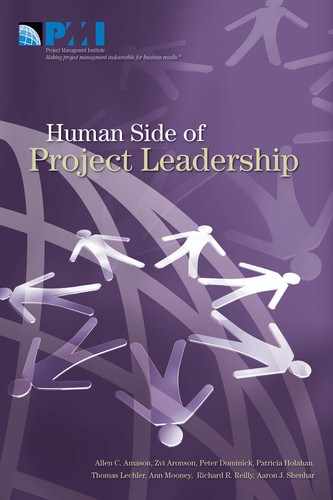CHAPTER 12
Conclusions
Our case data provide support for the idea that a project’s spirit is a manifestation of the project’s goal in terms of team member’s emotions, attitudes, and expected behaviors—termed the expression—components of project spirit. The project manager can regulate principal behaviors of participants in project settings by shaping spirit expressions (see Table 11-2). We provide the following set of recommended spirit-building block activities for project leaders concerned with shaping and managing the components of project spirit as a part of their planning activities.
- Excitement/passion, enthusiasm and joy are emotional expression- components of project spirit that will be influenced by infusing the project’s own vision.
- a. Creating excitement by infusing the project’s vision—The project manager articulates a meaningful and exciting project vision, expressing the value of the project and its expected competitive advantage once the project is completed.
- Morale, satisfaction and commitment are attitudinal expression-components of project spirit that will be influenced by the project leader’s values as manifested in this leader’s activities
- a. Nurturing project member attitudes by infusing the project leader’s values—The project leader demonstrates behaviors that represent values which encourage personal and professional development, a culture of inclusion and quality, to influence the attitudinal component of spirit.
- Culture is an expression—component of project spirit that will be influenced by social rituals and symbols applied by the project manager.
By sponsoring such social rituals, the project manager sends a clear message that teamwork is an important and intensive investment of time and energy, and acquisition of new ideas and skills that support teamwork are expected. Rituals that include customers, suppliers, and internal stakeholders can engender a culture of inclusion.
The project manager can introduce new symbols, for example, layout and design of the work environment, policy, dress code, and other concrete objects to signify the desired behaviors of project members, to shape the culture expression component of spirit. Introducing such symbols represents the extent that equality, synergy, and open communication are expected by the project leader.
Taken together, our studies show that exceptional project leaders concentrate on the human energy that creates spirit. Leaders can play a critical role in shaping project spirit by carefully selecting participants—based on their beliefs that not all organizational members will function effectively in unique project settings, particularly in projects that might be challenging or operate under high-technology uncertainty conditions. Success in creating the right spirit for the right project may be attributed in a large part to the leaders’ abilities to infuse their own project vision and values, and to instill symbols and social rituals into their daily interactions with project participants. The challenge of achieving exceptional project outcomes appears to relate to the way project leaders integrate the shaping of project spirit as part of their planning activities, with the hard, cold analysis of technology, customers, markets, and competitors.
